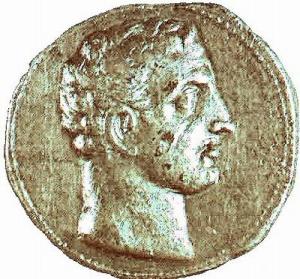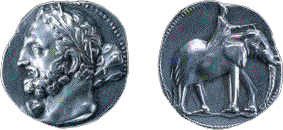Eurasian Origin of Berbers and modern North Africans
Essentially the same thing, as North Africans are mainly Arabized Berbers..
Essentially, about ten thousand years ago a population wave from the near East swept over North Africa, bringing in gracile Mediterranean people in the Capsian era. A later wave of immigration occurred in the Neolithic when the expanding farmers from the near east ploughed their way across North Africa, some leaving artwork in the central Sahara to mark their passage. As far as DNA studies can tell, the Arab invasions that converted North Africans to Islam made virtually no impact to the population; essentially they converted the local population and didn’t replace them. There was a only trace contribution made to North Africa by Europe during the Barbary slavery era, but quite a significant amount of sub Saharan maternal ancestry was added. The modern North African is mainly Eurasian in ancestry, and cluster with Europeans and west Asians. To quote Cavalli Sforza..
Berbers are located primarily in the northern regions of Algeria and Morocco, but somewhat to the interior, usually not far from the sea. . Berbers are believed to have their ancestors among Capsian Mesolithics and their Neolithic descendants, possibly with genetic contributions from the important Neolithic migrations from the Near East. It is reasonable to hypothesize that the Berber (Afro-Asiatic) language was introduced by the Neolithic farmers
Anyway, this page has a few links to DNA studies of North Africans, which I should really start updating. I’s not complete. One day I will redo the whole thing to be neater and more comprehensive.
Sean Myles1, 2 , Nourdine Bouzekri1, Eden Haverfield1, 3, Mohamed Cherkaoui4, Jean-Michel Dugoujon5 and Ryk Ward1
(1) Institute of Biological Anthropology, University of Oxford, Oxford, UK
(2) Department of Evolutionary Genetics, Max-Planck Institute for Evolutionary Anthropology, Deutscher Platz 6, 04103, Leipzig, Germany
(3) Department of Human Genetics, University of Chicago, 920 East 58th Street, Chicago, IL 60637, USA
(4) Laboratoire dEcologie Humaine, Facult? des Sciences-Semlalia, Universit? Cadi Ayyad, Morocco
(5) Centre dAnthropologie CNRS,, University of Toulouse, UMR 8555, France
Received: 15 November 2004 Accepted: 23 December 2004 Published online: 2 April 2005
Abstract The process by which pastoralism and agriculture spread from the Fertile Crescent over the past 10,000 years has been the subject of intense investigation by geneticists, linguists and archaeologists. However, no consensus has been reached as to whether this Neolithic transition is best characterized by a demicdiffusion (witha significant genetic input from migrating farmers) or a culturaldiffusion (without substantialmigration of farmers). Milk consumption and thus lactose tolerance are assumed to have spread with pastoralism and we propose that by looking at the relevant mutations in and around the lactase gene in human populations, we can gain insight into the origin(s) and spread of dairying. We genotypedthe putatively causal allele for lactose tolerance (–13910T) and constructed haplotypes from several polymorphisms in and around the lactase gene (LCT) in three NorthAfrican Berber populations and compared our results with previously published data. We found that the frequency of the –13910T allele predicts the frequency of lactose tolerance in several Eurasian and North African Berber populations but not in most sub-Saharan African populations. Our analyses suggest that contemporary Berber populations possess the genetic signature of a past migration of pastoralistsfrom the Middle East and that they share a dairying origin withEuropeans and Asians, but not with sub-Saharan Africans.
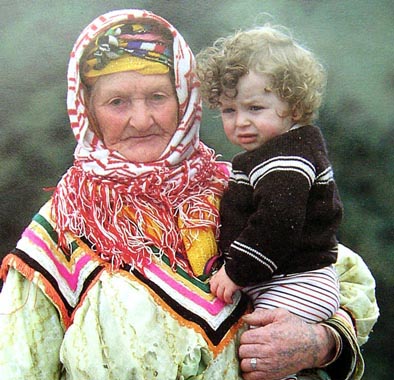
Mitochondrial DNA heterogeneity in Tunisian Berbers
Berbers live in groups scattered across NorthAfrica whose origins and genetic relationships with their neighbours are not well established. The first hypervariablesegment of the mitochondrial DNA (mtDNA) control region was sequenced in a total of 155 individuals from three Tunisian Berber groups and compared to other North Africans. The mtDNA lineages found belong to a common set of mtDNA haplogroups already described in NorthAfrica. Besides the autochthonous North African U6 haplogroup, a group of L3 lineages characterized by the transition at position 16041 seems to be restricted to North Africans, suggesting that an expansion of this group of lineages took place around 10500 years ago in NorthAfrica, and spread to neighbouring populations. Principal components and the coordinate analyses show that some Berber groups (the Tuareg, the Mozabite, and the Chenini-Douiret) are outliers within the NorthAfrican genetic landscape. This outlier position is consistent with an isolation process followed by genetic drift in haplotypefrequencies, and with the high heterogeneity displayed by Berbers compared to Arab samples as shown in the AMOVA. Despite this Berber heterogeneity, no significant differences were found between Berber and Arab samples, suggesting that the Arabization was mainly a cultural process rather than a demographic replacement.
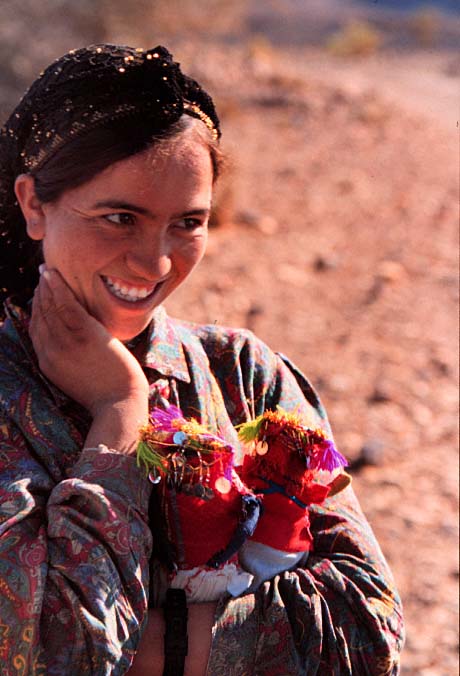
Genetic studies have emphasized the contrast between North African and sub-Saharan populations, but the particular affinities of the North African mtDNA pool to that of Europe, the Near East, and sub-Saharan Africa have not previously been investigated. We have analysed 268 mtDNA control-region sequences from various Northwest African populations including severalSenegalese groups and compared these with the mtDNAdatabase. We have identified a few mitochondrial motifs that are geographically specific and likely predate the distribution and diversification of modern language families in North and West Africa. A certain mtDNA motif (16172C, 16219G), previously found in Algerian Berbers at high frequency, is apparently omnipresent in Northwest Africa and may reflect regional continuity of more than 20,000 years. The majority of the maternal ancestors of the Berbers must have come from Europe and the Near East since the Neolithic.The Mauritanians and West-Saharans, in contrast, bear substantial though not dominant mtDNAaffinity with sub-Saharans.
This is actually a bit innacurate, as the approximate arrivalof a lot of the Eurasian DNA , excluding U, coincides withthe Neolithic expansion and arrival of the Capsian culture about 10,000 years ago (from Cranio facial studies of ancient Magrebian skulls). The Capsians show a gracile build and small face traceable to the eastern Mediterranean.
The faces of modern North Africa.
Polymorphism of Six Alu Insertions in Morocco: Comparative Study between Arabs, Berbers, and Casablanca Residents
Abstract Alu elements are the largest family of short tandem interspersed elements (SINEs) in human who have arisen to a copy number with an excess of 500 000 copies per haploid human genome and mobilize through an RNAse polymerase III derived transcript in a process termed retroposition. Several features make Alu insertions a powerful tool used in population genetic studies: the polymorphic nature of many Alu insertions, the stability of an Aluinsertion event and, furthermore, the ancestral state of an Alu insertion is known to be the absence (complete and exact) of the Alu element at a particular locus and the presence of an Alu insertion at the site that forward mutational change. Here we report on the distribution of six polymorphic Aluinsertions in a generalMoroccan population and in the Arab and Berber populations from Morocco and their relationships with other populations previously studied. Our results show that there is a small difference between Arabs and Berbers and that the Arab population was closer to African populations than Berber population which is closest to Europeans.
Mitochondrial DNA transit between West Asia and North Africa inferred from U6 phylogeography
Nicole Maca-Meyer1 , Ana M Gonz?lez1 , Jos? Pestano2 , Carlos Flores1 , Jos? M Larruga1 and Vicente M Cabrera1
Published: 16 October 2003
Abstract
World-wide phylogeographicdistribution of human complete mitochondrial DNA sequences suggested a West Asian origin for the autochthonous North African lineage U6. We report here a more detailed analysis of this lineage, unraveling successive expansions that affected not only Africa but neighboring regions such as the Near East, the Iberian Peninsula and the Canary Islands.
Results
Divergence times, geographic origin and expansions of the U6 mitochondrial DNA clade, have been deduced from the analysis of 14 complete U6 sequences, and 56 different haplotypes, characterized by hypervariable segment sequences and RFLPs.
Conclusions
The most probable origin of the proto-U6 lineage was the Near East. Around 30,000 years ago it spread to North Africa where it represents a signature of regional continuity. Subgroup U6a reflects the first African expansion from the Maghrib returning to the east in Paleolithic times. Derivative clade U6a1 signals a posterior movement from East Africa back to the Maghriband the Near East. This migration coincides with the probable Afroasiatic linguistic expansion. U6b and U6c clades, restricted to West Africa, had more localized expansions. U6b probably reached the Iberian Peninsula during the Capsian diffusion in North Africa. Two autochthonous derivatives of these clades(U6b1 and U6c1) indicate the arrival of North African settlers to the Canarian Archipelago in prehistoric times, most probably due to the Saharan desiccation. The absence of these Canarian lineages nowadays in Africa suggests important demographic movements in the western area of this Continent.
The Emerging Tree of West Eurasian mtDNAs: A Synthesis of Control-Region Sequences and RFLPs
Variation in the human mitochondrial genome (mtDNA) is now routinely described and used to infer the histories of peoples, by means of one of two procedures, namely, the assaying of RFLPsthroughout the genome and the sequencing of parts of the control region (CR). Using 95 samples from the Near East and northwest Caucasus, we present an analysis based on both systems, demonstrate their concordance, and, using additional available information, present the most refined phylogeny to date of west Eurasian mtDNA. We describe and apply a nomenclaturefor mtDNA clusters. Hypervariable nucleotides are identified, and the relative mutation rates ofthe two systems are evaluated. We point out where ambiguities remain. The identification of signature mutations for each cluster leads us to apply a hierarchical scheme for determining the cluster composition of a sample of Berber speakers, previously analyzed only for CR variation. We show that the main indigenous North African cluster is a sister group to the most ancient cluster of European mtDNAs, from which it diverged ?50,000 years ago.
MtDNA Profile of West Africa Guineans: Towards a Better Understanding of the Senegambia Region
Alexandra Rosa et al.
The matrilineal genetic composition of 372 samples from the Republic of Guin?-Bissau (West African coast) was studied using RFLPsand partial sequencing of the mtDNA control and coding region. The majority of the mtDNA lineages of Guineans (94%) belong to West African specific sub-clusters of L0-L3 haplogroups. A new L3 sub-cluster (L3h) that is found in both eastern and western Africa is present at moderately low frequencies in Guinean populations.A non-random distribution of haplogroups U5 in the Fula group, the U6 among the “Brame” linguistic family and M1 in the Balanta-Djola group, suggests a correlation between the genetic and linguistic affiliation of Guinean populations. The presence of M1 in Balanta populations supports the earlier suggestion of their Sudanese origin. Haplogroups U5 and U6, on the other hand, were found to be restricted to populations that are thought to represent the descendants of a southern expansion of Berbers.Particular haplotypes, found almost exclusively in East-African populations, were found in some ethnic groups with an oral tradition claiming Sudanese origin.
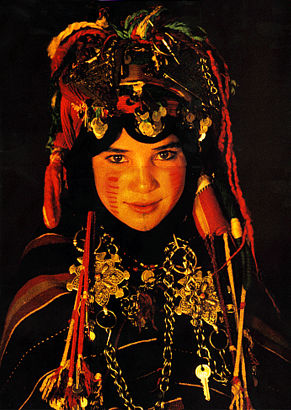
A possible ancient migration from Asia to Africa was proposed by Cruciani et al. (2002) to explain the presence of some unusual Y-chromosome lineages identified in West Africa. Haplogroup R1 (defined by M173 mutation), without further branch defining mutations (M269 and M17) specific to Europeans, accounted for ~40% of the Y-chromosomes in North-Cameroon, while not yethaving been sampled elsewhere in Africa. More data from Central and Western Africa are needed to cast light on the origin of such idiosyncratic mtDNA and Y chromosome lineages. Thus, our U5 sequences from the Guinean Fulbe people corroborate Cruciani’s hypothesis of a prehistoric migration from Eurasia to West Sub-Saharan Africa, testified by their present day restricted and localised distribution
Alu insertion polymorphisms in NW Africa and the Iberian Peninsula: evidence for a strong genetic boundary through the Gibraltar Straits
Abstract An analysis of 11 Alu insertion polymorphisms (ACE, TPA25, PV92, APO, FXIIIB, D1, A25, B65, HS2.43, HS3.23, and HS4.65) has been performed in several NW African (Northern, Western, and Southeastern Moroccans; Saharawi; Algerians; Tunisians) and Iberian (Basques, Catalans, and Andalusians) populations. Genetic distances and principal component analyses show a clear differentiation of NW African and Iberian groups of samples, suggesting a strong genetic barrier matching the geographical Mediterranean Sea barrier. The restriction to gene flow may be attributed to the navigationalhazards across the Straits, but cultural factors must also have played a role. Some degree of gene flow from sub-Saharan Africa can be detected in the southern part of North Africa and in Saharawi and Southeastern Moroccans, as a result of a continuous gene flow across the Sahara desert that has created a south-north cline of sub-Saharan Africa influence in North Africa. Iberian samples show a substantial degree of homogeneity and fall within the cluster of European-based genetic diversity.
The population history of North Africa is particularly interesting because, although the region belongs to continental Africa, its history has been completely different from the sub-Saharan part. The peopling of the region has been influenced by two strong geographical barriers: the Sahara Desert to the south, which splits the African continent into two differentiated regions, and the Mediterranean Sea to the north, which separates the European and African continents. These geographical barriers may have constrained human movements in NorthAfrica into an east-west gradient, although they were not impermeable to human movements. During the first half of the Holocene, the humid climate that prevailed in the Sahara produced a receding of the desert allowing human settlements, but over the past 5000 years, the Sahara Desert has suffered a gradual aridification and has become as dry as it is nowadays (Said and Faure 1990). Historicalrecords document extensive trade routes that were established across the desert between sub-Saharan Africa and the north coast. In contrast, since the time of the Phoenicians, the city-based settlement pattern of the NW African coast integrated the area into the Mediterranean world. The seaward orientation of populations persisted and, similar to the desert, separated the Maghreb (NW Africa) from the rest of Africa to the south (Newman 1995). Moreover, during the 8th century AD, Berbers from North Morocco and Algeria under Arab leadership crossed the Mediterranean Sea and occupied the Iberian Peninsula for almost eight centuries, although the demographic impact of the conquest is thought to be limited (Hitti 1990).
Until recently, few genetic studies have been performed in NW Africa. In the latest compilation of classical genetic markers in North Africa (Bosch et al. 1997), the first principal component (PC) of gene frequencies showed an east-west pattern of genetic differentiation, in agreement with the geographical barrier imposed by the Sahara and the Mediterranean. Recent work with autosomal short tandem repeats (STRs; Bosch et al. 2000), mitochondrial DNA (mtDNA) sequences (Rando et al. 1998), and Y-chromosome haplotypes (Bosch et al. 1999) has suggested that the gene flow between NW Africa and Iberia and that between sub-Saharan Africa and NW Africa has been small. MtDNA variation in NW Africa (Rando et al. 1998) has shown a high frequency (up to 25%) of geographically specific sequences (named haplogroup U6) that is essentially absent in the Iberian Peninsula (from 0% in Andalusians to 5% in Portuguese). The mtDNA analysis has shown a limited gene flow from Europe to NW Africa that could be attributed to recent human movements.The study of Y-chromosome haplotypes (Bosch et al. 1999) shows little admixture between NW Africa and the Iberian Peninsula. The study of 21 autosomal STR loci in NW Africa has also shown a clear genetic difference between NW African populations and Iberians, although some degree of gene flow into Southern Iberia (Andalusians) can be detected (Bosch et al. 2000).
Diversit? mitochondriale de la population de Taforalt (12.000 ans bp – maroc): une approche g?n?tique a l’?tude du peuplement de l’afrique du nord.
(Mitochondrial diversity in the Taforalt population (circa 12,000 BP, Morocco): a genetic approach to the study of the peopling of North Africa.)
ABSTRACT:
The population exhumed from the archaeological site of Taforalt in Morocco (12,000 years BP) is a valuable source of information toward a better knowledge of the settlement of Northern Africa region and provides a revolutionary way to specify the origin of Ibero-Maurusian populations. Ancient DNA was extracted from 31 bone remains from Taforalt.The HVS1 fragment of the mitochondrial DNA control region was PCR-amplified and directly sequenced. Mitochondrial diversity in Taforalt shows the absence of sub-Saharan haplogroups suggesting that Ibero-Maurusian individuals had not originated in sub-Saharan region.Our results reveal a probable local evolution of Taforalt population and a genetic continuity in North Africa.
Eurasiatic component (J/T, H, U et V) and North African component (U6).
Genetic structure of Taforalt:
Eurasiatic Component : H, U, JT, V: 90.5%
North African component: U6: 9.5 %
42, 8% (9/21) H or U
14, 2% (3/21) JT
2 individuals (9,5%) U6
Essentially, the DNA studies of Berbers observe that they are mostly similar to Eurasians, and that they appear to have arrived in North Africa about 30,000 years ago plus (Mechta Afaloupeople), with a second wave of colonisation in the neolithic from the Near East confirmed by the cranio facial measurements (Loring Brace) of neolithic North Africans. Then then migrated South during the saharan wetphase about 12,000 years ago, with Eurasian Y chromosome now making up 40% of Cameroon’s Y chromosomes as a result (although less in other areas).
All these prehistoric NorthAfricans are described as mostly similar to other Mediterranean Caucasian populations, with a lesser similarity to Nubians from the Wadi Halfa area. There’s a simplified explanation of ancient North African population movements here
Edit to Blog..
To the mad Afrocentrist ‘Nubian’ who claims that these DNA studies prove Berbers are all black and that the white Berbers are the descendants of slaves…
Please show where any of these studies say that.. Because they don’t, at all. They point out that Berbers are mostly Caucasian and that they’ve been in North Africa a very long time.
Explain why every anthropologist who’s looked at Mahgrebian bones in the Holocene describes them as mainly Caucasian Mediterranean.
Explain why the Egyptians uniformly portrayed Libyans as white Caucasians, as they North Africans did on their own art work.
Explain why all the contemporary art and descriptions of the Moors all show a majority Caucasian population.
Why the Guanches, an isolated North African group since the BC’s were all white people with plentiful blondes, if all Berbers were black untill ‘Moorish slavery whitened up North Africa’?
Also, for those who insist in the face of overwhelming evidence they were all black in North Africa until European slaves whitened them up..
From the Roman era in Libya. All the Roman era mosaics show a mainly Caucasoid light skinned population in North Africa, as does the rock art.
Carthage era coins, with two coins showing Hannibal.
The Tassili ladies, from Algeria (age unclear, but sometime in the BC). I have a wider collection of images here.
I also have a 16th century image of the contemporary Guanches; pure blood North Africans with no European or sub Saharan ancestry mixed in, isolated on the Canary islands since about 500 BC, alone for about 1,000 years until the Spanish invaded.
In the brown skin clothing. As you can see he is pretty indistinguishable from the Spaniard holding him.
I would also like to point out that the Tuareg at not ‘the only real Berbers’ as is often claimed. In fact, they are related to the Beja, and are relatively recent arrivals in North West Africa who have adopted Berber customs. They are also about half Eurasian in ancestry. The recent contribution of Europeans to the North African genepool is 4% for males, and probably less than 2% for females; 12,000 year old DNA studies show only Eurasian derived mt DNA in ancient North Africans from Morocco. It isn’t likely to be very high though, as the majority of Barbary slaves were males. A good comparison would be the Arabian peninsula. About 8 million or so slaves were imported from Eaest Africa into this area, but only about 10% of the Mt DNA there is African. By contrast about 1.25 million Europeans ended up on the Barbary coast, so this is unlikely to have made a difference of more than a couple of percent to the whole. Way more black African slaves were imported into the area during the Barbary slavery era, so the net difference is probably that they are slightly darker than they used to be.
I’d also like to point out to those who feel the need to spam me with descriptions of Berbers as black or brown from old European texts…
Europeans used these words differently back then. Brown was used to describe anyone with a moderate tan, black was a skin tone of a dark tan seen with black hair and dark eyes. Ladies and children had white skin. Europeans commonly called anyone with black hair and a heavy tan black, so believing that black in medieval/renaissance literature refers to a black African is incorrect. In fact, you can find references to Jews, Turks and Spaniards as being black. Gypsies were still referred to as black into the 20th century. See below. Black Africans are referred to as Ethiopians in these old texts.
The men were very black, with their hair frizzled, the women were the most ugly and the blackest that were ever seen. .. they had sorceresses amongst them , who by pretended to look into peoples hands, to tell them what had or would happen to them…” p. 153 of The Christian journal and Literary Reigster published I 1827 by T & J. Swords? Photo Arabian gypsies , European gypsies James Michener’s Iberia Spanish Travels and Reflections 1968.
18?? – “We were not far from Pressburg when at once we heard in the distance, a singing, shouting and hallooing which continually grew nearer. Presently we met four wagons, in which a brown company of gypsies were seated. It was a curious sight. Their sat men and women, girls and boys all dark as half-negroes, in ragged array, with long shining hair, smeared after Hungarian fashion with lard…We gazed at them in astonishment…” Wanderings of a Journeyman Tailor through Europe and the East: During the years 1824 to 184
COMMENTS POLICY.
Unfortunately necessary, as Afrocentrists feel the need to spam this page with moronic comments. All comments need to be approved by me before they’ll appear. They won’t be posted unless…
* They are an intelligent comment
* I’m in a bad mood and feel like ridiculing someone (Dana/Don).






